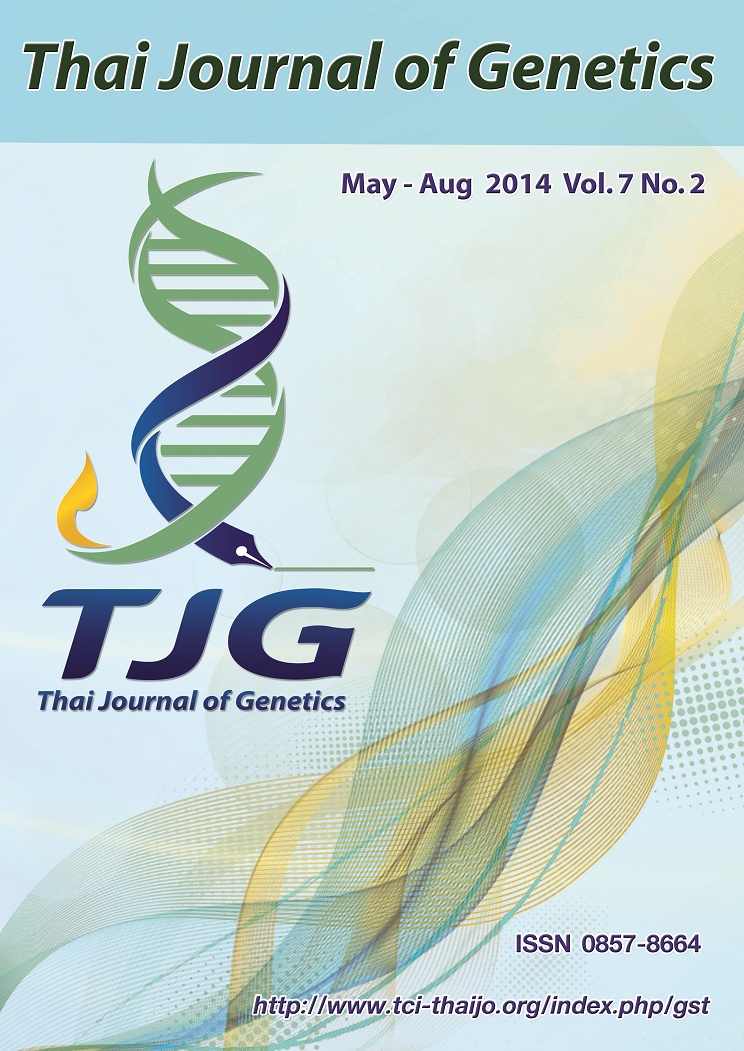Genetic differentiation in natural populations and their mass culture stocks of Drosophila ananassae
DOI:
https://doi.org/10.14456/tjg.2014.15Keywords:
Drosophila ananassae, Inversion polymorphism, Genetic identity, Genetic differentiationAbstract
Natural populations and their mass culture stocks of Drosophila ananassae were analyzed for the frequencies of three cosmopolitan inversions. The frequency of ST gene rearrangement was recorded to be high in both natural populations as well as in the mass culture stocks. Furthermore, out of three cosmopolitan inversions, the AL and DE had higher occurrence showing their adaptive significance to this species. ET inversion that persists in all populations, was thinly represented than the other two. These natural populations, coming from different geographical localities, showed very little genetic variation. The mass culture stocks also showed almost similar genetic composition as their respective natural populations. Various parameters of population genetics were computed in order to find out genetic structure of the natural populations. The results indicate that genetic changes in the natural populations have scarcely undergone, and no significant genetic differentiation could be observed when natural populations were compared with the respective mass culture stocks.
References
Alahiotis S, Pelecanos M, Zacharopoulou A (1976) A contribution to the study of linkage disequilibrium in Drosophila melanogaster. Can J Genet Cytol 18: 739–745.
Anderson WW, Dobzhonsky T, Kastritsis CD (1967) Selection and inversion polymorphism in experimental populations of Drosophila psuedoobscura initiated with the chromosomal constitutions of natural populations. Evolution 21: 664–671.
Ayala FJ, Tracey ML, Barr LG, McDonald JF, Perez-Salas S (1974) Genetic variations in natural populations of five Drosophila species and the hypothesis of selective neutrality of protein polymorphisms. Genetics 73: 343–384.
Da Cunha AB (1960) Chromosomal variation and adaptation in insects. Annu Rev Entom 5: 85–110.
Da Cunha AB, Dobzhansky T (1954) A further study of chromosomal polymorphism in Drosophila willistoni in its relation to the environment. Evolution 8: 119–134.
De Frutos R (1978) Changes of chromosomal polymorphism in experimental cage populations of Drosophila subobscura. Genetica 49: 139–151.
Dobzhansky T (1970) Genetics of Evolutionary process. Columbia University Press. New York.
Dobzhansky T, Spassky NP (1962) Genetic drift and natural selection in experimental populations of Drosophila psuedoobscura. Proc Natl Acad Sci USA 48: 148–156.
Dobzhansky T, Pavlovsky O (1957) An experimental study of interaction between genetic drift and natural selection. Evolution 11: 311–319.
Fontdevila A, Ruiz A, Alonso G, Ocana J (1981) The evolutionary history of Drosophila buzzatii. I. Natural chromosomal polymorphism in colonized populations of the Old World. Evolution 35: 148–157.
Fukatami A (1976) Chromosomal polymorphism in natural population of Drosophila lutescens. Jap J Genet 51: 265-–276.
Futch DG (1966) A study of speciation in South
Pacific populations of Drosophila ananassae. Univ. Texas Publ. 6615: 79–120.
Hartl DL (1981) A primer of population genetics. Sinauer Associates, Inc, Sunderland, Mass.
Hedrick PW (1983) Genetics of populations. Science Books International, Inc. Portola Valley, California.
Inque Y (1979) The fate of polymorphic inversions of Drosophila melanogaster transferred to laboratory conditions. Jpn J Genet 54: 83–96.
Larruga JM, Cabrera VM, Gondalez AM, Gullion A (1983) Molecular and chromosomal polymorphism in continental and insular populations from the south western range of Drosophila subobscura. Genetica 60: 191–205.
Nei M (1972) Genetic distance between populations. American Naturalist 106: 283–292.
Parsons PA (1973) Behavioural and ecological genetics, a study in Drosophila. Clarendon Press Oxford.
Pinsker W, Sperlich D (1979) Allozyme variation in natural populations of Drosophila subobscura along a north-south gradient. Genetica 50: 207–214.
Powell JR (1973) Apparent selection on enzyme alleles in laboratory populations of Drosophila. Genetics 75: 557–570.
Powell JR, Levene H, Dobzhonsky T (1972) Chromosomal polymorphism in Drosophila psuedoobscura used for diagnosis of geographical origin. Evolution 26: 553–559.
Powell JR, Richmond RC (1974) Founder effects and linkage disequilibrium in experimental populations of Drosophila. Proc Natl Acad Sci USA 71: 1663–1665.
Prevosti A, Ocana J, Alonso G (1975) Distances between populations of Drosophila subobscura, based on chromosome arrangement frequencies. Theor Appl Genet 45: 231–241.
Ratnam D, Singh AK (2008) Quantitative distribution of the cosmopolitan paracentric inversions in mass culture and isofemale lines of Drosophila ananassae. J Exp Zool 11: 465–468.
Singh AK (2000) Chromosomal polymorphism in natural populations of Drosophila ananassae from Sultanpur, Uttar Pradesh. J Exp Zool 3: 93–96.
Singh BN (1998) Population genetics of inversion polymorphism in Drosophila ananassae. Ind J Exp Biol 36: 739–748.
Singh BN (2013) Genetic polymorphisms in Drosophila. Current Science 105: 461–469.
Singh BN, Das A (1992) Changes in inversion polymorphism in laboratory populations of Drosophila melanogaster. Z Zool Syst Evolut-forch 30: 268–280.
Singh P, Singh BN (2007) Population genetics of Drosophila ananassae, genetic differentiation among Indian natural populations at the level of inversion polymorphism. Genetical Research 89: 191–199.
Singh P, Singh BN (2008) Population genetics of Drosophila ananassae. Genetical Research 90: 409–419.
Singh RS, Hicky DA, David J (1982) Genetic differentiation between geographically distant
populations of Drosophila melanogaster. Genetics 101: 235–256.
Sperlich D (1973) Populations genetik. Stuttgart, G. Fischer.
Sperlich D, Pfriem P (1986) Chromosomal polymorphism in natural and experimental populations. In: Ashburner M, Carson HL, Thompson Jr JR (eds) The genetics and biology of Drosophila. London Acedemic Press, pp 257–309.
Watanabe TK, Anderson WW, Dobzhansky T, Pavlovsky O (1970) Selection in experimental populations of Drosophila pseudoobscura with different initial frequencies of chromosomal variants. Genetical Research 15: 123–129.
Weir BS, Cockerham CC (1984) Estimating F-statistics for the analysis of population structure. Evolution 38: 1358–1370.
Wright S (1951) The genetical structure of populations. Annals of Eugenics 15: 323–354.
Wright S (1978) Evolution and genetics of populations. Vol. 4. Variation within and among natural populations. Univ Chicago Press, Chicago, Illinoi.



